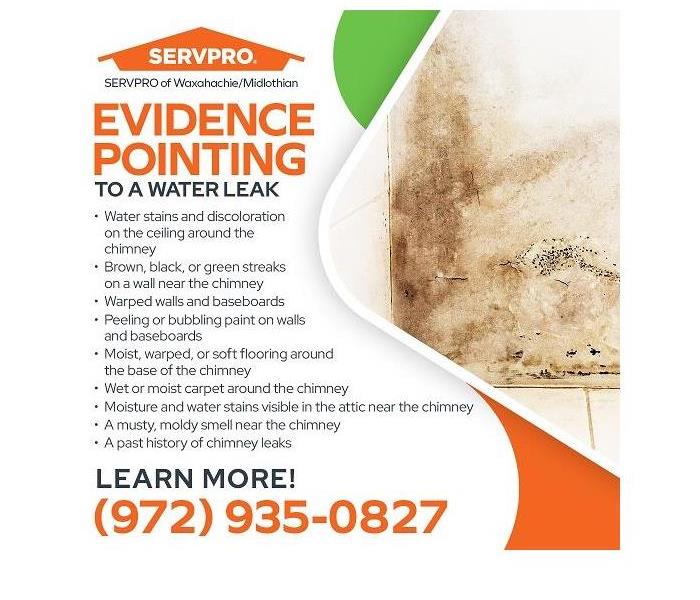Spotting and Diagnosing Water Intrusion From a Chimney Leak
2/11/2022 (Permalink)
Blog Summary: SERVPRO of Waxahachie/Midlothian explains how to identify a leaking chimney and offers tips on how to deal with the water damage.
When water damage from a leaking chimney is discovered, homeowners can turn to SERVPRO of Waxahachie/Midlothian for water damage restoration. Technicians have the equipment, knowledge, and skills needed to restore walls, ceilings, and floors suffering from water damage caused by a chimney leak. If secondary damage includes a mold infestation, the SERVPRO team can also provide mold remediation services to clients in Red Oak, TX, and the surrounding area.
How to Spot Chimney Leaks
A relaxing evening by a warm, cozy fire in the fireplace is one of winter’s most enjoyable pleasures. Homeowners need to be aware that the fireplace and chimney system can appear to be functioning properly while the chimney is actually leaking and causing water damage. Moisture can penetrate chimney systems through a variety of entry points, and the chimney system, the roof, and the interior of the home can suffer a water damage disaster. Some water damage is evident in the early stages of the leak; signs include brown or bronze water stains on ceilings and walls close to the chimney. Other signs are hidden and difficult to spot. Unfortunately, many homeowners do not recognize even the obvious signs as evidence of a moisture leak. By educating themselves about what a chimney leak looks like, homeowners can intercept the water intrusion before it becomes more severe.
Evidence Pointing to a Water Leak
A water intrusion from a leaking chimney will usually first appear during or after severe weather involving heavy rainfall and high winds. Long periods of high humidity and a steady drizzle or downpour can also result in a chimney leak. The following signs indicate a leak is present:
- Water stains and discoloration on the ceiling around the chimney
- Brown, black, or green streaks on a wall near the chimney
- Warped walls and baseboards
- Peeling or bubbling paint on walls and baseboards
- Moist, warped, or soft flooring around the base of the chimney
- Wet or moist carpet around the chimney
- Moisture and water stains visible in the attic near the chimney
- A musty, moldy smell near the chimney
- A past history of chimney leaks
Potential Sources of the Leak
The source of a chimney leak is often challenging to pinpoint. The water intrusion may run along support beams or rafters for several feet before finally dripping onto the ceiling or running down a wall. A homeowner or property manager can avoid thousands of dollars on water damage restoration and structural repairs by conducting periodic inspections of the chimney. Here are some signs that a chimney might be leaking and causing water damage.
Defective mortar
Mortar joints must be watertight. If the mortar is missing or has deep fissures or cracks, moisture can make its way into the home. During cold weather, the water in these fissures can freeze, and the expansion enlarges the fissures, causing the moisture issue to worsen. If deteriorating mortar is caught early, a procedure called “tuckpointing” can be implemented. Tuckpointing involves removing deteriorated mortar and replacing it with fresh mortar; as a result, the chimney looks refreshed, and the water intrusion issue is resolved.
Damaged or improperly installed flashing
Often, chimney leaks are caused by faulty flashing. Flashing serves to create a watertight seal where the chimney and roof connect. Installation requires a high level of skill and expertise. Sometimes damage to the flashing is visible. Gaps between the flashing and the chimney bricks should not be visible but should be filled with caulking or another sealant.
Damaged or missing chimney cap
The chimney cap is installed over the flue to prevent rain, snow, and sleet from falling directly into the chimney. If the cap is damaged or missing, a water intrusion can result.
Cracked mud cap
The chimney crown or the mud cap is a mortared area on the top of the chimney designed to keep water from seeping between the flue and the chimney exterior. The mortar deteriorates rapidly under temperature extremes. If not detected early, cracks in the mud cap can lead to water damage in the home.
For more information about water damage cleanup in Red Oak, TX, contact the office by phone at (972) 935-0827. The team of restoration and cleaning professionals can also be reached by email at acarey@SERVPRO10932.com



 24/7 Emergency Service
24/7 Emergency Service
